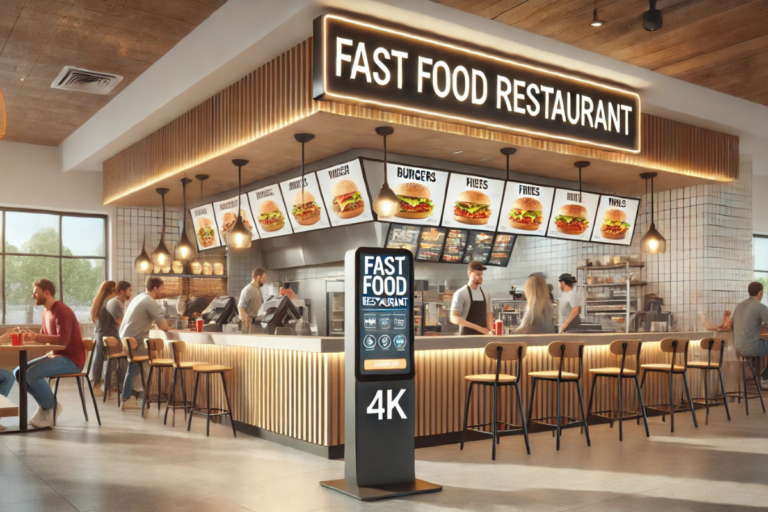Introduction to Fast Food Restaurants
What is a Fast Food Restaurant?
A fast food restaurant, also known just as a “fast food joint,” serves food that gets prepped and served very quickly. The meals here can be ordered at a counter or drive-thru window, and they are typically cheaper because they are easy to make. Many of these restaurants also offer options to dine in, though a lot of people take their food to go.
Brief History of the Fast Food Industry
The fast food industry started in the United States with the opening of A&W in 1919, which began selling root beer, and White Castle in 1921, known for its small, square hamburgers. These places set the stage for many others to follow. By the 1950s and 1960s, fast food chains like McDonald’s and KFC spread rapidly, influenced by the growing car culture and the demand for quick, affordable meals. Today, this industry spans across the globe, offering a wide range of food options from burgers to sushi, meeting the needs of busy customers everywhere.
The Business Model of Fast Food Chains
Overview of How Fast Food Chains Operate
Fast food chains have a straightforward approach to food service: they focus on speed, consistency, and affordability. These restaurants rely on a system where the preparation process is streamlined to ensure that food is made fast and in a way that every item tastes the same at any location. This model uses technology and standardization, from cooking methods to customer service protocols, ensuring efficiency across all outlets.
Discussion on Franchising and Company-Owned Outlets
Most fast food chains grow through franchising, where individuals can buy the rights to open and operate a restaurant under the chain’s brand name. This allows for rapid expansion and market penetration without the company bearing all the operational costs. Some outlets are company-owned, meaning the parent company manages day-to-day operations, which helps in maintaining strict control over quality and service standards. Both models have their merits and help fast food chains maintain a widespread presence.
Top Fast Food Chains in America
Highlight Some of the Most Popular Fast Food Chains
Chains like Starbucks, Whataburger, and Chipotle stand out in the fast food industry. Starbucks, known for its coffee and drink specialties, has become a daily stop for millions seeking quick service and a comfortable environment. Whataburger, famed in Texas and beyond, offers a range of hearty burgers and breakfast items that keep customers returning. Chipotle provides a fresh take on fast food with its customizable Mexican bowls and burritos, emphasizing fresh ingredients.
Mention Their Specialties and Customer Favorites
At Starbucks, customer favorites include seasonal drinks like the Pumpkin Spice Latte and year-round offerings like the Caramel Macchiato. Whataburger is beloved for its unique burgers, like the Patty Melt and the Honey BBQ Chicken Strip Sandwich. Chipotle is popular for its build-your-own concept with options such as sofritas, barbacoa, and freshly made guacamole. Each of these chains has carved out a niche by offering distinctive flavors that cater to the tastes and preferences of a broad customer base.
Menu Innovations and Signature Items
How Menu Items Can Define a Brand
Fast food restaurants often define their brand through signature menu items. For example, Starbucks is renowned for its seasonal specialties like the Pumpkin Spice Latte, which heralds the arrival of fall and attracts a dedicated following. Whataburger’s fresh, never-frozen burgers, like their famous Whataburger itself, help distinguish it from other burger joints by emphasizing quality and taste. These signature items not only attract customers but also create a unique identity that sets the chain apart.
Explore Unique Menu Items from Different Chains
Many fast food chains innovate their menus to keep customer interest high. For instance, McDonald’s periodically introduces items like the McRib, which has a cult following due to its limited availability. Taco Bell experiments with novel concepts like the Doritos Locos Tacos, blending familiar flavors in unexpected ways. These innovations help chains stay relevant in a competitive market and often become key items that define their brand.
Nutritional Information and Health Considerations
General Discussion on Calorie Counts and Nutritional Content
Fast food is often criticized for high calorie counts and questionable nutritional content. However, many chains are responding to health trends by offering more balanced options. For example, salads, fruit cups, and grilled items are becoming common in menus that were once dominated by fried foods and sugary drinks. Nutritional information is now more transparent, allowing customers to make informed choices about their meals.
Public Perception and the Impact of Health Trends on Fast Food Menus
The public’s increasing awareness of health issues like obesity and diabetes has influenced fast food menus significantly. Chains are incorporating healthier, lower-calorie options and highlighting the nutritional values of their foods. This shift is in response to consumer demand for more wholesome dietary choices and the broader health trends steering people away from traditional fast food fare.
Economic Impact of Fast Food Restaurants
Analysis of the Fast Food Industry’s Contribution to the Economy
The fast food industry is a major player in the global economy. It not only generates billions of dollars in annual revenue but also contributes significantly through franchise fees, taxes, and employment. The sector supports a wide range of supply chain activities, from agriculture to transportation, amplifying its economic impact.
Employment Opportunities Provided by Fast Food Chains
Fast food restaurants are one of the largest employers in the service sector, providing jobs to millions of people worldwide. These jobs range from entry-level positions to careers in management and corporate roles. For many, the industry offers a first job, flexible scheduling, and the opportunity for advancement within the company, playing a crucial role in job creation and economic stability.
Cultural Influence and Global Reach
How Fast Food Adapts to Different Cultures Globally
Fast food chains have successfully globalized by adapting their menus to cater to local tastes and cultural preferences. For example, McDonald’s serves McSpicy Paneer in India and Teriyaki McBurger in Japan, showcasing how they customize offerings to fit local cuisines. This strategy not only respects cultural differences but also draws in a broader customer base by aligning with regional dietary habits.
Case Studies of International Success Stories Like Panda Express and Chipotle
Panda Express has thrived by offering American-Chinese cuisine that appeals to a wide audience, integrating flavors that resonate well across different palates. Meanwhile, Chipotle has expanded internationally by maintaining its standard menu but also offering regional specials, demonstrating that a core menu with slight adaptations can succeed globally.
Customer Loyalty and Marketing Strategies
The Role of Marketing in Building Brand Loyalty
Marketing plays a crucial role in building brand loyalty in the fast food industry. Effective branding, consistent advertising, and promotions keep customers returning. Loyalty programs, like Starbucks Rewards, offer perks that encourage frequent visits, reinforcing customer relationships and fostering brand loyalty.
Examples of Successful Marketing Campaigns from Top Chains
Starbucks’ “Red Cup Campaign” during the holiday season and Domino’s transparency campaign that highlighted their “Pizza Turnaround” after customer feedback are prime examples of successful marketing strategies that boosted their brand images and customer loyalty.
The Future of Fast Food Restaurants
Innovations Leading the Future of Fast Food
The future of fast food looks promising with innovations like plant-based menu options catering to a growing demand for vegetarian and vegan diets. Digital ordering through apps and touchscreens in stores are also making the ordering process quicker and more efficient, aligning with the tech-savvy consumer base.
Predictions on How Consumer Preferences Might Evolve
As health awareness increases, more consumers are likely to demand healthier options. Sustainability will also play a larger role, with customers expecting eco-friendly packaging and ethically sourced ingredients. Additionally, the convenience of delivery services and mobile ordering is expected to continue growing, shaping the fast food industry to be more technology-driven.
Conclusion
Fast food restaurants have become an integral part of modern culture, symbolizing convenience and adaptability in a fast-paced world. Their ability to innovate continuously, from menu items to marketing strategies, not only keeps them relevant but also deeply ingrained in the daily lives of millions globally. As these chains expand, they carry with them a slice of home for travelers and a taste of the world for locals, proving that food really can bring people together, despite differing backgrounds.
Looking ahead, the fast food industry is poised to evolve even further, driven by technology and changing consumer preferences. With a growing emphasis on health, sustainability, and digital integration, fast food restaurants must continue to adapt and innovate. The future promises more personalized dining experiences tailored to the new age consumer, ensuring that the global appeal of fast food remains as strong as ever. This ongoing transformation will likely see fast food chains leading the charge in the broader restaurant industry’s growth and innovation.


